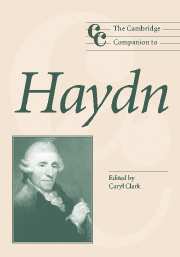Book contents
- Frontmatter
- Part I Haydn in context
- Part II Stylistic and interpretive contexts
- Part III Genres
- 7 Orchestral music: symphonies and concertos
- 8 The quartets
- 9 Intimate expression for a widening public: the keyboard sonatas and trios
- 10 Sacred music
- 11 The sublime and the pastoral in The Creation and The Seasons
- 12 Miscellaneous vocal genres
- 13 Haydn in the theater: the operas
- Part IV Performance and reception
- Index
12 - Miscellaneous vocal genres
from Part III - Genres
Published online by Cambridge University Press: 28 September 2011
- Frontmatter
- Part I Haydn in context
- Part II Stylistic and interpretive contexts
- Part III Genres
- 7 Orchestral music: symphonies and concertos
- 8 The quartets
- 9 Intimate expression for a widening public: the keyboard sonatas and trios
- 10 Sacred music
- 11 The sublime and the pastoral in The Creation and The Seasons
- 12 Miscellaneous vocal genres
- 13 Haydn in the theater: the operas
- Part IV Performance and reception
- Index
Summary
When the Leipzig publisher Breitkopf & Härtel decided to print the collected works of Joseph Haydn in 1799, the firm actually meant the complete edition of the keyboard works. Clavier music was highly marketable, satisfying the insatiable demand by amateurs making music in the drawing room, and Breitkopf hoped to expand and increase their market through this medium. The twelve volumes of the final product – ambitiously titled Oeuvres complettes de Joseph Haydn (1800–6) – comprises solo and accompanied sonatas (trios), and solo and part-songs with keyboard accompaniment. Interestingly, accompanied songs were still considered keyboard rather than vocal music at the time, just as they had been in various German collections since the mid-eighteenth century. Volumes VIII–IX of the Oeuvres complettes include nearly all the German Lieder, the English canzonettas, the cantata Arianna a Naxos, and the thirteen part-songs for three or four voices – exactly the repertory discussed in this chapter.
What was Haydn's most popular music around 1800, however, would later become the most neglected. Viewed as precursors to the great song repertories of Franz Schubert and Robert Schumann, and damned for their inferior texts, Haydn's songs were regarded as unworthy of a composer possessing his talents and abilities. Like the solo keyboard sonatas, which since the 1970s have formed part of the regularly performed sonata repertory and are no longer viewed as inferior predecessors to the sonatas of Mozart and Beethoven, Haydn's songs are gradually being rediscovered by present-day singers and keyboardists.
- Type
- Chapter
- Information
- The Cambridge Companion to Haydn , pp. 164 - 175Publisher: Cambridge University PressPrint publication year: 2005
- 1
- Cited by



